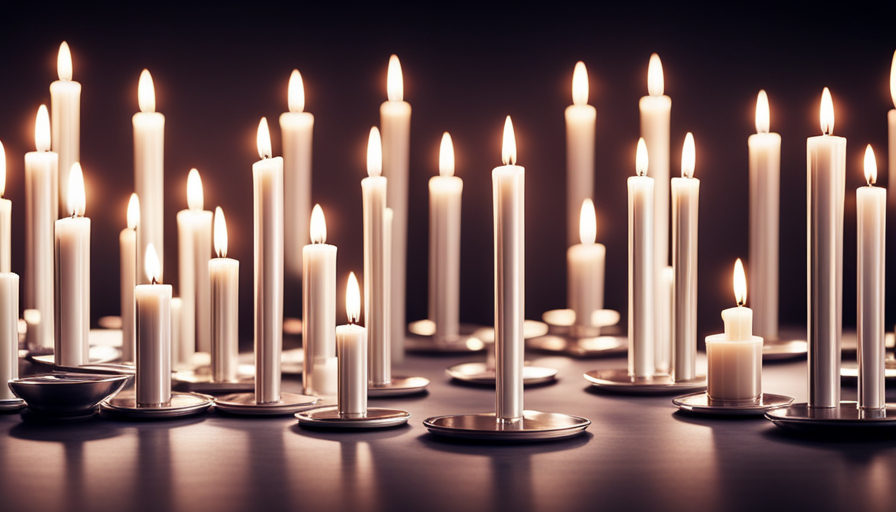When I sketch a candle, I am not only capturing its physical appearance but also the feelings of warmth, light, and tranquility that it represents. Holding my pencil and letting my imagination flow brings me a sense of calm and peace.
In this article, I will guide you through the steps to draw a candle with precision and detail. We will start by gathering our materials and then move on to creating basic shapes that form the foundation of our artwork. From there, we will add intricate details and texture to bring our candle to life. With shading techniques, we’ll enhance depth and highlights to create a realistic glow. And finally, we’ll draw the flickering flame that dances elegantly atop our masterpiece.
So grab your sketchbook and join me as we explore the art of drawing candles together!
Key Takeaways
- Candle symbolism: warmth, light, tranquility
- Steps to draw a candle with precision and detail
- Materials needed: paper, pencil, eraser, colored pencils/markers
- Experiment with different candle shapes and sizes
Gather Your Materials
You’ll need to gather your materials before you can start drawing a candle. To draw a candle, you will need a few supplies: paper, pencil, eraser, and colored pencils or markers if you want to add color to your drawing. Once you have gathered all the necessary materials, you’re ready to begin.
First, take out a sheet of paper and place it on a flat surface. Make sure your pencil is sharpened and your eraser is within reach. It’s important to have a clean workspace so that you can focus on your drawing without any distractions.
Next, let’s start with some basic shapes. Begin by sketching an elongated rectangle for the body of the candle. Then, draw a smaller circle at the top of the rectangle to represent the flame. Use light strokes when sketching these shapes so that they can be easily erased later on.
Now that we have outlined the basic structure of our candle, we can move on to adding more details in the next section about ‘start with basic shapes’.
Start with Basic Shapes
To create a candle, begin by shaping the basic foundation with circles and rectangles, like molding clay into its desired form. Start by sketching a vertical rectangle to represent the body of the candle. This will serve as your guide for proportions.
Next, draw a small circle on top of this rectangle to indicate where the flame will be placed later on. Now that you have established the general shape of the candle, it’s time to explore different candle shapes. Candles can come in various forms such as tapered candles, pillar candles, or even novelty-shaped candles like animals or fruits. Experiment with different widths and heights to achieve the desired look for your candle drawing.
As you move on to add details and texture in the next section, remember that shading plays an important role in making your drawing appear realistic. Softer shadows should be present around curved areas like the base and sides of the candle. Additionally, consider adding subtle lines or strokes along the sides of the candle to represent wax drips or uneven textures. These details will bring your drawing to life and make it more visually interesting.
Transitioning into adding details and texture…
Add Details and Texture
Get creative with the details and texture in your candle drawing to bring it to life and make it visually captivating. Explore different candle textures to add interest and realism to your artwork. Experiment with smooth, glossy candles or rough, textured ones. Consider how the light will interact with the different surfaces and create highlights and shadows accordingly.
One technique that can add depth to your candle drawing is cross-hatching. Cross-hatching involves drawing a series of lines that intersect each other at various angles. This creates shading and texture on the surface of the candle. Start by lightly sketching out the basic shape of your candle, then use short, overlapping strokes to build up layers of cross-hatching.
Remember to pay attention to the direction of your strokes as well. Vary the angle and spacing between your lines to create different effects, like highlights or shadows. Take your time with this step and observe how light falls on real candles for reference.
By adding these details and texture through techniques like exploring different candle textures and using cross-hatching, you can bring depth and realism into your candle drawing. Now let’s move on to creating shading and highlights in our next step.
Create Shading and Highlights
Adding shading and highlights can enhance the three-dimensional effect of your candle artwork, making it more visually dynamic and engaging. Did you know that properly executed shading can make an object appear more realistic by creating the illusion of depth?
To create shading and highlights on your candle drawing, you can use various techniques. One effective method is using cross hatching. You draw closely spaced parallel lines in one direction and then add another set of lines in a different direction to create darker areas. This technique adds depth and dimension to your candle.
Blending techniques are also essential for creating realistic candle textures. You can use blending stumps or your fingers to softly blend the colors together, giving the wax a smooth and natural appearance. By carefully blending the shadows with the lighter areas, you can achieve a realistic gradient effect.
When adding shading and highlights, remember to observe how light falls on a real candle. Identify where the light source is coming from and apply shadows accordingly. Also, pay attention to the reflections created by the flame or surrounding objects.
Now that we’ve perfected our shading and highlighting techniques, let’s move on to learning how to draw the flame without writing "step."
Draw the Flame
The flickering flame dances gracefully, casting a warm glow against the dark canvas. Drawing the flame of a candle requires some specific techniques to capture its essence. To create a realistic flame, start by sketching the basic shape using light pencil strokes. Then, use darker lines to define the outer edges and add details like wisps and curves to mimic the movement of fire.
To bring your drawing to life, it’s important to understand the colors of a flame. Flames typically have different hues depending on their temperature. In a candle flame, the lower portion appears blue while the upper part transitions into shades of yellow and orange. To achieve this effect in your drawing, use varying shades of these colors and blend them together smoothly.
To help you visualize this process better, here is a table that breaks down the colors found in a candle flame:
| Flame Zone | Color |
|---|---|
| Inner Core | Blue |
| Middle Layer | Yellow |
| Outer Layer | Orange |
| Tips | Red |
Now that we’ve covered drawing techniques and discussed flame colors, let’s move on to adding shadows and reflections for an even more realistic representation of our candle’s glow.
Add Shadows and Reflections
To truly capture the essence of a flickering flame, it’s essential to incorporate shadows and reflections. This allows for a more immersive and lifelike portrayal of its warm glow. When drawing shadows and reflections on the candle surface, there are a few key points to keep in mind:
-
Understanding the importance of lighting: Shadows and reflections are created based on how light interacts with objects. To create realistic shadows, consider the position and intensity of your light source. The direction of the light will determine where shadows fall on the candle surface.
-
Creating realistic shadows: Use shading techniques such as cross-hatching or stippling to depict areas that receive less light. Gradually build up layers of shading to add depth and dimension to your drawing.
-
Adding reflections: Reflective surfaces like wax can create interesting highlights on candles. Identify areas where light bounces off the surface and use lighter shades or white pencil strokes to represent these reflections accurately.
-
Blending for realism: Smooth out harsh lines by blending shadows and reflections seamlessly into the surrounding areas using tools like blending stumps or cotton swabs.
By incorporating these techniques, you can enhance your candle drawing by creating convincing shadows and reflections that bring it to life. In our next section, we’ll explore how to enhance your artwork further with colors and gradations without losing the warmth of its glow.
Enhance with Colors and Gradations
With the infusion of vibrant hues and gradual transitions, your artwork will radiate an irresistible warmth that captivates the viewer. Using color psychology in candle drawings is an effective way to enhance the overall mood and atmosphere of your artwork.
Warm colors like red, orange, and yellow can evoke feelings of coziness and intimacy, while cool colors like blue and purple can create a sense of calmness and tranquility. Experiment with different color combinations to find the perfect palette for your candle drawing.
In addition to color, exploring different lighting effects in candle drawings can add depth and realism to your artwork. Consider how the light source interacts with the candle flame and wax. Shadows cast by the flame can create interesting shapes and patterns on surrounding objects or surfaces. Reflections on the wax can also be incorporated to convey a sense of shine and texture.
By using color psychology and experimenting with lighting effects, you can bring your candle drawing to life.
The next section will delve into how you can use different types of candles for inspiration, expanding on these techniques without skipping a beat.
Use Different Types of Candles for Inspiration
Expanding your artistic horizons, exploring various types of candles can ignite a wellspring of inspiration for your artwork. Not only do different candle scents evoke unique emotions and atmospheres, but the candle making process itself offers a plethora of visual elements to incorporate into your drawings.
To kickstart your creative journey, consider the following ideas:
-
Classic wax candles: Experiment with traditional tapered candles or pillar candles to capture their elegant simplicity and timeless beauty.
-
Scented candles: Explore the world of aromatherapy by drawing scented candles that embody different moods and feelings.
-
Novelty candles: Have fun with whimsical designs like animal-shaped or food-inspired candles, allowing your imagination to run wild.
-
Handmade candles: Capture the intricacies of homemade creations, showcasing the imperfections and personal touches that make them special.
By studying these diverse types of candles, you’ll gain insights into their shapes, textures, and colors, which can inform your drawing techniques. So grab your sketchbook and let these inspirations light up your artwork!
Now that you’ve explored different types of candles for inspiration in creating art pieces, it’s time to experiment with various drawing techniques to bring those ideas to life.
Experiment with Different Drawing Techniques
When it comes to drawing a candle, there are endless possibilities for creativity. In the previous subtopic, I discussed using different types of candles as inspiration for your drawings. Now, let’s take it a step further and explore various drawing techniques that will bring your candle to life.
To truly capture the essence of a candle, it is important to experiment with different drawing techniques. By trying out various approaches, you can achieve different effects and add depth to your artwork. For example, you could use cross-hatching to create texture on the candle’s surface or stippling to give it a more realistic appearance.
Additionally, exploring various shading techniques will help you add dimension and realism to your drawing. You can utilize techniques such as blending or hatching to create highlights and shadows that mimic the glow of a real flame.
To emphasize the importance of these techniques, consider this table:
| Technique | Effect |
|---|---|
| Cross-hatching | Texture |
| Stippling | Realism |
| Blending | Highlights |
| Hatching | Shadows |
By incorporating these methods into your artwork, you can enhance the overall look and feel of your candle drawing. So go ahead, try different drawing techniques and explore various shading methods to make your candle come alive on paper! Remember, practice makes perfect–so don’t forget to have fun along the way!
Practice and Have Fun!
Go ahead and have a blast practicing your artistic skills, it’s all about enjoying the process! Now that you’ve experimented with different drawing techniques, it’s time to put your newfound knowledge into practice and have some fun.
As you continue on your journey of learning how to draw a candle, take the opportunity to explore different candle shapes and textures.
When exploring different candle shapes, pay attention to the overall silhouette of the candle. Candles can come in various forms, such as tall and slender or short and stout. Experiment with drawing candles that are tapered at the top or ones that have a consistent width throughout. Don’t be afraid to get creative and try out unique shapes like spiral candles or twisted ones.
In addition to exploring different shapes, also focus on capturing various candle textures. Candles can have smooth surfaces or be adorned with intricate designs like ribbons or flowers. Pay attention to details such as wax drips, melting edges, or even cracks in the surface. These small elements can add depth and realism to your drawings.
Remember, practicing is key when it comes to improving your artistic skills. Take the time to sketch multiple candles using different shapes and textures. Observe real-life candles for inspiration or search for reference images online. Have fun experimenting with various techniques until you find what works best for you. Enjoy the process of honing your drawing skills while creating beautiful representations of candles!
Frequently Asked Questions
How long does it take to become skilled at drawing candles?
It takes time and dedication to become skilled at drawing candles. Effective practice methods for improving candle drawing skills include studying different types of candles, practicing basic shapes and proportions, and experimenting with shading techniques.
To incorporate unique and creative elements into your candle drawings, consider adding intricate details like melted wax drips or decorative patterns. Remember to observe real candles closely for inspiration and always strive to improve your skills through consistent practice.
What are some common mistakes to avoid when drawing a candle?
When drawing a candle, there are some common mistakes to avoid. One of the most frequent errors is not paying attention to the proportions of the candle. It’s essential to accurately depict its height and width.
Another mistake is neglecting the details, such as the melted wax or the flame’s flickering motion.
Lastly, be cautious with shading, as it can easily make your drawing appear flat if done incorrectly.
Can I use colored pencils instead of graphite pencils for shading and highlights?
Yes, you can definitely use colored pencils for shading and highlights in your candle drawing. In fact, using watercolor pencils can add a unique touch to your artwork. They allow you to create soft gradients and blend colors seamlessly. When shading, apply light pressure and build up layers gradually to achieve depth and dimension. To blend the colors smoothly, you can use a blending tool or simply layer multiple colors together with gentle strokes.
Are there any specific drawing techniques that work best for capturing the texture of a candle?
When it comes to capturing the texture of a candle in your drawing, there are a few techniques that work best.
One effective method is using cross-hatching, where you create intersecting lines to represent the rough surface of the candle.
Another technique is stippling, which involves creating small dots or marks to give the illusion of texture.
Additionally, blending with a tortillon or blending stump can help create a smooth and realistic appearance for your candle drawing.
How can I make my candle drawing look more realistic and three-dimensional?
To enhance depth and create a realistic sense in candle drawings, there are a few tips I’ve found useful.
First, shading is crucial. By using varying degrees of darkness and highlights, you can give your drawing dimensionality.
Additionally, pay attention to details to capture the intricate texture of a candle. Use techniques like cross-hatching or stippling to replicate the roughness or smoothness of the wax.
These methods will bring your candle drawing to life with impressive realism and three-dimensionality.
Conclusion
Well, there you have it, folks! Drawing a candle may seem like a simple task, but as we’ve learned today, it takes a whole lot of skill and technique. From gathering your materials to adding those intricate details and textures, every step is crucial.
Remember to create shading and highlights to give your candle that realistic touch. And don’t forget the flame! Drawing the flame is like the cherry on top of an already beautiful cake.
Finally, enhance your masterpiece with colors and gradations for that extra wow factor. So go ahead, grab your pencils and paper, and let your creativity shine bright like a candle in the dark!
















